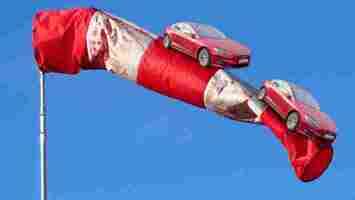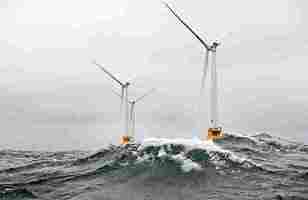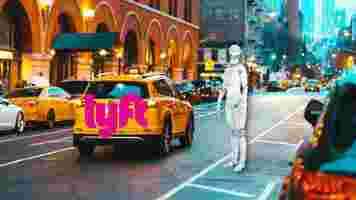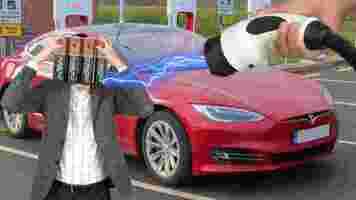Are wind-powered cars a reality or just science fiction?
This article was originally published by Martin Banks on Clean Fleet Report , a publication that gives its readers the information they need to move to cars and trucks with best fuel economy, including electric cars, fuel cells, plug-in hybrids, hybrids and advanced diesel and gasoline engines.

Is Air Power Blowing Over the Horizon?
At the moment, the most viable mode of sustainable transportation is an electric vehicle (EV). With more and more automakers announcing new EV designs every year, it’s reasonable to believe that EVs are here to stay.
However, some automakers are exploring different forms of green energy — specifically, wind. Are wind-powered cars a possibility, or are they something that’s likely to stay in the realm of science fiction?
The Potential of Wind Power
The idea of using wind for transportation is thousands of years old, with some experts citing dates as far back as 5000 B.C . We’ve used massive cloth sails to capture the wind’s energy and harness it to move ships across the oceans for centuries.
On a smaller scale, airboats use enormous turbines to generate thrusts across the water in shallow or congested areas where a traditional propeller would get snagged.


We use that same ancient technology today in wind farms to generate electricity. Each tower has two or three enormous blades that, when moved by the wind, turn a rotor, which spins a turbine and generates electricity.
Right now, electric cars are the best option for someone looking for an eco-friendly car, but unless your home runs on wind or solar energy, you’re still contributing to climate change by utilizing power generated by burning fossil fuels.
As we start to make the transition to green energy, this concern will fade away. What if we could skip the middleman and use wind energy generated directly by the vehicle?
The Toyota Mirai and Other Examples
Some examples of wind-powered vehicles look exactly like you expect they would — small, sleek vehicles with low ground clearance and enormous turbines attached to the top.
One example is the Ventmobile , built by University of Stuttgart students in 2008. It’s not the kind of thing you’d see driving down the highway, but it does prove the point that wind-powered vehicles are possible.
Toyota and Lotus are among those trying to translate wind power into a more viable option for the everyday driver. The Lotus Nemesis doesn’t have to run on wind power , but its electric powertrain is designed to run on wind-turbine generated electricity by its builder, Ecotricity, a UK renewable energy company.
The Toyota Mirai is a little bit different. Not only can it combine wind power and hydrogen , but the hydrogen to power the fuel cell can be generated with wind power.
It’s probably one of the cleanest and greenest cars in the world right now. Unfortunately, there’s only a few thousand currently on the roads around the world, but they’re a fantastic proof of concept.
Are Wind-Powered Cars on the Horizon?
A lot of the technology that we take for granted today was science fiction a few decades ago. Are wind-powered cars on the horizon? Possibly, but we’re not there yet, at least not for 100 percent wind power.
We may see a lot more cars like the Nemesis and Mirai in the future before we start seeing vehicles capable of fully operating on nothing more than a stiff breeze.
You can follow Clean Fleet Report on Twitter and Facebook .
Do EVs excite your electrons? Do ebikes get your wheels spinning? Do self-driving cars get you all charged up?
Then you need the weekly SHIFT newsletter in your life. Click here to sign up .
Lyft gives up on developing its own self-driving tech, sells division
Like Uber, ride-hailing platform Lyft has sold its self-driving division. It’s a massive u-turn for the company considering that just last year, it said it was planning to launch its first robotaxi fleet in 2023.

Let’s take a closer look at what’s happened.
The deal
On Tuesday this week, Lyft announced an acquisition agreement with Toyota’s Woven Planet Holdings (WPH).
The deal sees WPH buy Lyft’s self-driving division, called Level 5, for $550 million in cash.
As TechCrunch reports , Lyft will receive $200 million upfront, with the remaining $350 million paid in installments over the next five years.
Most of Level 5’s staff will also move over to WPH, how their work will continue however depends on what the Toyota subsidiary decides to do with it.
The deals should officially close in the third quarter of this year.
The why
The reason why Lyft has sold its self-driving division couldn’t be simpler: it needs to make money, more specifically it needs to turn a consistent profit.
By getting rid of its self-driving division Lyft is able to remove $100 million of yearly operating expenses.
According to the company’s co-founder and president John Zimmer, if the deal goes through in the expected time frame, it will leave Lyft in a position of profitability by the end of the year.
Bear in mind, as NY Times reports , Lyft lost $1.8 billion last year, so it’s still got a lot to fix before it becomes profitable.
The dream
It’s worth noting, while Lyft is selling its self-driving efforts, it’s not wiping its hands clean entirely.
The company is still intent on autonomous robotaxis being a huge part of its future.
As such, it’s made commercial agreements that would see Woven Planet use the Lyft platform if it solves the self-driving puzzle.
Lyft will continue to maintain relationships with other autonomous vehicle development companies as well, for the same reasons.
A leaf out of Uber’s book
You might feel like you’ve read this story before, and in a way you probably have.
Late last year, ride-hailing giant Uber sold its own self-driving division to autonomous vehicle startup Aurora, in pursuit of profit.
There was no definitive value placed on that deal, but valuations suggest it was around $4 billion. That’s leagues more than Lyft’s sale, but the principle of the sale was the same: Uber is under increasing pressure to turn a profit, and so is getting rid of excess financial baggage.
In both cases, the companies have been sure to keep some skin in the self-driving car game.
The ride-hailing firms might not be giving up on robotaxis entirely, but the painful reality of business and needing to make a return on all that VC investment is finally hitting home.
Do EVs excite your electrons? Do ebikes get your wheels spinning? Do self-driving cars get you all charged up?
Then you need the weekly SHIFT newsletter in your life. Click here to sign up .
Tesla needs to lead the world on vehicle-to-grid charging — get on it, Musk
After adverse weather, thousands are without power and water in Texas . Freezing temperatures and snow last week knocked out vital parts of the grid, which are still yet to be restored.

To lend a hand, one ingenious Tesla owner shared a hack for how they turned their electric car into an external power source. In doing so, they have been able to heat their home, and keep their refrigerator running.
Unfortunately, the hack appears to have damaged the car. Rubbing salt into the wound, Tesla isn’t going to fix it under warranty.
The debacle was spotted by Tesla critic Greentheonly on Twitter, after it was shared in a Portland-focused Tesla owner’s group on Facebook.
In the images, it seems that the Tesla hacker has connected an inverter directly to the car’s 12 volt battery. According to owner forums , the 12 volt battery is recharged by the car’s main high-voltage battery pack, the one that powers the motors.
So, this system allows the inverter to draw power from the car’s main power pack via the 12 volt system, which isn’t exactly recommended.
In fact, Tesla says that using the car as an external power source will invalidate the warranty. If these are the lengths drivers have to go to, it’s understandable why that’s the case.
This whole situation, though, points to a larger issue and opportunity: that electric vehicles have the potential to be incredibly useful in times of natural disaster or power outages.
A fully charged Tesla has the capability of powering the average US home for at least a couple of days under normal use, which in emergency situations could be critical in keeping people safe until power can be restored. If you were careful you could probably power a house for a week.
Tesla is no stranger to helping those in need when it can. On previous occasions, it has given free access to its Supercharger network to those who are fleeing areas affected by natural disaster.
The EV maker has also extended the range of its cars for those trying to escape tropical storms.
While these gestures are great, the company now needs to consider what its cars are capable of doing when owners physically aren’t able to drive them. It needs to develop a legitimate way of letting owners power their homes from their cars, so that users don’t void their warranty or damage their car.
The concept of using your electric to power your home is nothing new. It’s better known as vehicle-to-grid charging , and it’s a huge opportunity for Tesla.
Given Tesla also has its Powerwall division, it knows everything it needs to know about using batteries to power homes. It’s uniquely placed to lead the way with V2G charging — and it absolutely should.
Unfortunately, Tesla is kind of anti-V2G. Things looked positive for a moment when an engineer posted a tear-down video of a Model 3 and suggested some of its charging hardware was capable of bi-directional charging. However, this was later debunked , and it turned out that the hardware in question had been misidentified.
Cases like this highlight what EVs are capable of. With natural disasters seemingly becoming more common, Tesla absolutely needs to get working on V2G charging, as do all EV makers for that matter, so they can provide a lifeline in times of need.
HT – Jalopnik
SHIFT is brought to you by Polestar. It’s time to accelerate the shift to sustainable mobility. That is why Polestar combines electric driving with cutting-edge design and thrilling performance. Find out how .